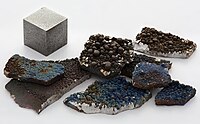
Photo from wikipedia
Abstract Depending on the in situ ligand transformation of 3,5-di(1,2,4-triazol-1-yl)benzonitrile (DTCN) to 3,5-di(1,2,4-triazol-1-yl)benzoic acid (DTCA) under hydrothermal condition, three polyoxometalate-based copper complexes, [CuI 4CuII 2(OH)2(H2O)4(DTCA)4(HPMoVI 10MoV 2O39)] (1), [Cu4(OH)2(H2O)4(DTCA)2(SiW12O40)]·11H2O (2),… Click to show full abstract
Abstract Depending on the in situ ligand transformation of 3,5-di(1,2,4-triazol-1-yl)benzonitrile (DTCN) to 3,5-di(1,2,4-triazol-1-yl)benzoic acid (DTCA) under hydrothermal condition, three polyoxometalate-based copper complexes, [CuI 4CuII 2(OH)2(H2O)4(DTCA)4(HPMoVI 10MoV 2O39)] (1), [Cu4(OH)2(H2O)4(DTCA)2(SiW12O40)]·11H2O (2), and {Cu2Cl(H2O)(HDTCA)2[CrMo6(OH)6O18)]}·4H2O (3), have been isolated through changing the polyoxoanions. Introducing Keggin-type polyoxoanions [PMo12O40]3− or [SiW12O40]4− to reaction systems, both 1 and 2 display 3-D framework structures containing Cu/DTCA metal-organic belts, and a kind of poly-Keggin chain derived from [PMo12O40]3− polyoxoanions exist in 1. When the Anderson-type polyoxoanion [CrMo6(OH)6O18)]3− is utilized, a 2-D grid-like layer resulted in 3, in which the DTCA ligands are embedded, revealing that the polyoxoanions have key roles in regulating the structures of complexes. The investigations on electrochemical properties and photocatalytic activities for the degradation of organic dyes of 1–3 have been carried out. Graphical Abstract
Journal Title: Journal of Coordination Chemistry
Year Published: 2020
Link to full text (if available)
Share on Social Media: Sign Up to like & get
recommendations!